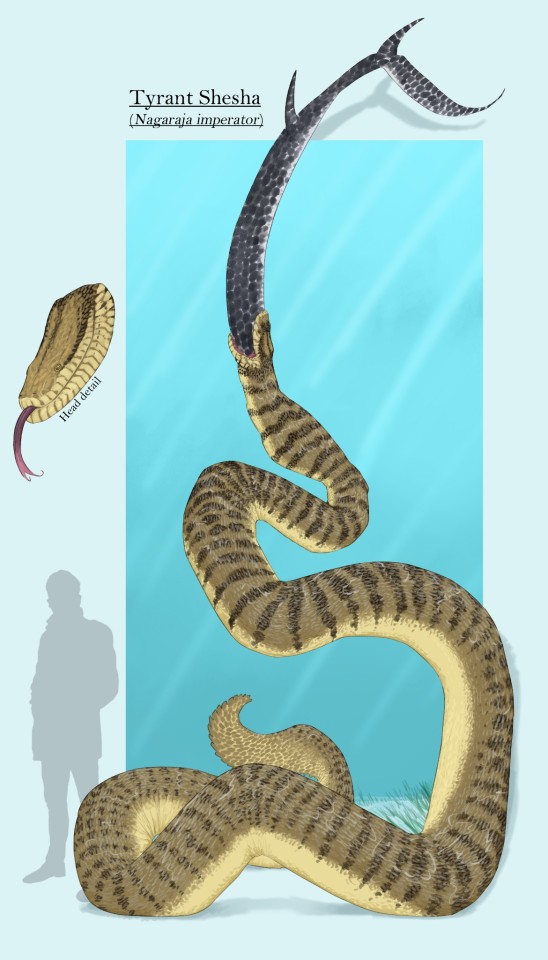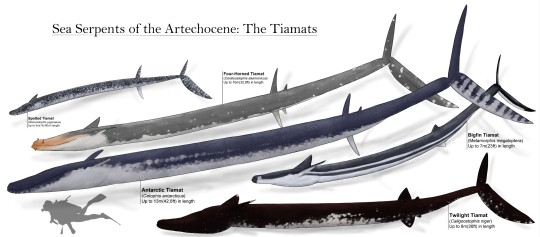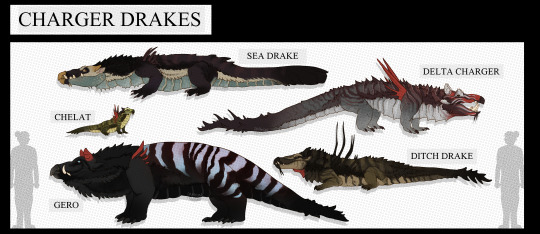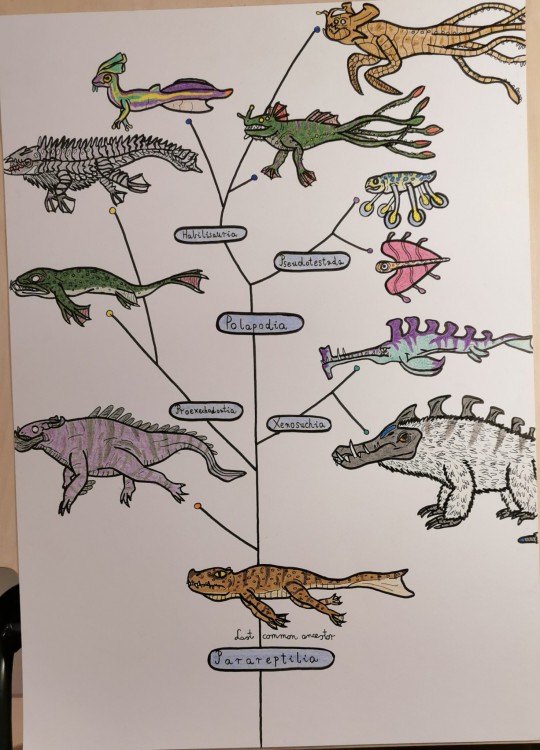#specs and the sea
Explore tagged Tumblr posts
Text

Thinking about what if whales evolved back into land creatures.
If you like what I do, feel free to leave a tip on Ko-Fi! :]
#os: unnamed#world: SpecEvo#color: normal colors#speculative evolution#speculative biology#spec evo#spec bio#creature design#artists on tumblr#whale#cetacean#sea creature
776 notes
·
View notes
Text

WHITE VEILED BEARFROG 🐻❄️ 🐠 (Ambystoma Axoqui) Also known as Iztacueyatl Tecuani (white frog beast)
"A majestic white scaled and bear-like creature from the seas. Its now dangerous habitat forced it to seek water ponds and swamps. But make no mistake, this beast in spite of its elegant appearance can tear its prey and foes to shreds- especially during nesting seasons. Its movement can be deceivingly slow but once in a rush of adrenaline they lunge and attack at a swift speed. To further improve its survivability it will often release slimy bubbles (likely mucus) from its body which slow down its enemies through contact or by walking on surfaces in which they bursted, but amongst other abilities they can absorb and release high-pressured water through their mouths (and gills) to blast intruders with. Some of them have even learned to propel themselves like a jet by expelling water, becoming a deadly giant projectile.
They prefer to live surrounded by corals and colorful rocks to blend in and only display aggression when threatened, as they prefer stealth. A bearfrog will create a semi-aquatic nest so that the females then carry a clutch of orange eggs under their bodies until they hatch. The newborn larvae will spend their youth underwater until they develop to venture into land.
This species has become rather scarce because of the water conditions in the land .."

#art#digital art#digital illustration#aesthetic#concept art#creature#digital drawing#fantasy#creature concept#creature art#creature design#monster#frog#fish#aquatic#sea creatures#nature#wildlife#speculative biology#speculative evolution#spec evo#white#orange#fin#veil#claws#bear#amphibian#ocean#monster art
852 notes
·
View notes
Text

Rejoice! Qhuavan arthropods (sea crawler bugs) be upon you
#have them 🤲#art#my art#speculative biology#spec bio#sea crawlers#vivere 44#aliens#worldbuilding#scifi#they're all aquatic#if people ask i might yap about them here#drew these for an rp event in my server lol. finally decided to post them
559 notes
·
View notes
Text


Festive Hellmouth Viper
Another giant spectral resident of Hellmouth, Depth Charge 7 🎊
788 notes
·
View notes
Text

a little silleyyy i concocted as i have come up with a bäckahäst relative, the "bäckabock" - or sea-ram, sea-goat, etc. i will write a bit about them and this guy below..
despite their name and appearence, the sea-goats are not goats at all but are a relative of the bäckahäst, and thus a cervid. unlike their much larger brethren, sea-goats are adapted to a more aquatic lifestyle, in that they have a better swimming ability (the bäckahäst, while good swimmers, tend to wade more often due to their size, and only really spend long in deeper water during winter). their hair has convergently evolved a structure similar to otters, and thus insulate themselves underwater through air that gets trapped in it.
their diet consists mostly of fish and shellfish, they especially favour clams, and unlike the bäckahäst does not hunt terrestrial prey much (although it does happen, especially during the winter). culturally, bäckahästar and sea-goats intermingle a decent amount, and historically they actually have gotten along well probably stemming from the fact that they prefer different territories anyway, and hunt different prey for the most part - although this varies of course depending on the culture in question, and human-caused habitat loss also plays a big role.
this guy in particular, gaerneh, is a stone-smith, which is a common occupation among both bäckahästar and sea-rams. both species have the peculiar tendency to swallow stones - their stomach has adapted a "crop" like organ where such stones are stored. the use of this is to control buoyancy in the water and they often swallow/regurgitate stones depending on the situation. Anyway stone-smiths will shape stones to be optimal for swallowing, and there are also folk beliefs among many cultures about what kind of stones are best, or what "blessing" they may bring oneself - like "this kind of stone beckons a bountiful hunt" for example.
stone-smiths sometimes stay among their own, and focus on smithing stones adapted best for their species. but a few try to learn how to smith for both - gaerneh is one of those!
#oc#original character#fantasy#spec bio#speculative biology#speculative evolution#spec evo#speculative fantasy#worldbuilding#pareidolia tag#oc: gaerneh#bestiary#artists on tumblr#original species#these guys are actually not based on a particular scandinavian folklore LOL#but on “sea goats” aka the thing u see represent capricorn lol#i just thought one day of a small bäckahäst subspecies... then went gasp... sea goat lookalike?!!?#so yes these guys are small... not sure just how small but at least pony size#like shetland pony size
234 notes
·
View notes
Text
A Titan of the Indian Ocean: The Tyrant Shesha
Slithering through the lush reefs and seagrass meadows of the Indian Ocean lurks a slow, calculating predator, one of the biggest and most dangerous one can find in these waters. The largest non-tiamat snake of the Artechocene, the Tyrant Shesha (Nagaraja imperator).

This titan is a naga, a member of a group of large python descendants that share mostly aquatic habits, large tail scales, sometimes forming a crocodilian-like tail paddle. Species that live in reefs like this one stay still in between rock crevices or below sediment for hours, waiting for prey to come close enough to launch their heads at it, no matter if the target is several times larger than one might expect a predator that size to take. After that, they usually stay without eating until it's fully digested usually coming out to shore to rest or breed.
The Tyrant Shesha however, is different, it has grown so large it can no longer support its own body, and remains underwater pretty much all of their adults lives, as only their young are small enough to go out of the water. Their size has its benefits though, as they are able to tackle the largest prey around: from sharks, to seabirds, to small to medium sized thalassochelonians, to the young of the largest animals of the Artechocene ocean, like Tiamats or Iricts.
One population, living in the Somalian seaway, takes advantage of the migratory patterns of the Spotted Tiamat, the smallest of the Tiamats.

They stalk the shallows where they come every few years to give birth en masse, and instead of feasting of the fast, relatively hard to catch newborns, they strike the large tired mothers as they finish delivering the next generation, and constrict them until they drown, dragging them to the seafood and swallowing them whole, a feast that can make them go for a few months without eating.
#art#illustration#clip studio paint#speculative evolution#speculative biology#spec evo#sea snake#year of the snake#The Artechocene Project
153 notes
·
View notes
Text
you wouldn't know it but the original lineart of the painting from yesterday was my attempt at a water scene with sipho nymphs and scalefish, two of the main animal groups found in high abundance around the spire

but my strength. my energy. i can't hold it for inventing wildlife i can't do it
#never call me a serious spec bio enjoyer. i hate sea creatures sm#ghsjkgh categorically not true but i just don't feel like doing my job outside work#setting: siren
95 notes
·
View notes
Text

Charger Drakes A highly varied family of Drakes that have characteristics and mannerism similar to crocodilians. They are mostly non-venomous animals and they all possess derived quills that have been turned into sensory organs. While they can no longer inject venom with these quills like most other drakes, they can use these quills to sense changes in pressure around their environment. For example, the Sea Drake uses its to feel for the movement of prey in its surrounding waters. The Ditch Drake will bury theirs into the soil of their holes to feel for movement in the ground around them. The Delta Charger however uses its quills mainly as a display structure but it maintains the ability to feel movement in the air and mud they wallow in.
Chelat are one of the only venomous Charger Drakes. Their venom is used to make medicine that removes heavy metals from the body. They are often taken as hatchlings and trained as service animals because they can sense peoples heart rates through the air.
The Gero is a domestic Charger Drake. They are kept in Anemoi as cart animals and have a mainly herbivorous diet versus their sister species who are hyper carnivores.
All Charger Drakes besides the Gero and Chelat are known for their aggressive nature and status in Ishidan and Anemoian culture as pests. They have very high prey drives, and do not eat for long stretches of time; so when food is available they will spend great effort towards hunting. All Charger Drakes like long rests, routine, and are food motivated.
#Ascendancy#speculative fiction#speculative biology#speculative evolution#spec evo#spectember#drake#charger drake#chargers#art#digital art#my art#digitalart#oc#artist#dragon#anemoi#ishida#chelat#ditch#sea#gero#delta
131 notes
·
View notes
Text
Having to go to school at 9 am means I can’t stay up writing till 3 am anymore 😭 😭 that’s when im at my most creative lmao
#katie’s writing updates#im working on chapter 4#souls of sea and storm#the chapter is kinda in 2 parts#and I’ve written the first 1200 of each part#though the smart thing would to make one part chapter 4#and one part chapter 5#i feel like it would be mean to make everyone wait for what happens in the second part or what would be chapter 5#cough cough the first valgrace mention#the first little spec of percabeth#guys I actually feel like I suck at writing romance#so im kinda scared for later in this story lol#pjo#riordanverse#valgrace#percabeth#percy fanfic#fanifc#pjo fanfic#ao3 fanfic
37 notes
·
View notes
Text

hoblo moment…



This is a perfectly preserved hoplopterygian. This specimen is believed to be a subadult, almost done with metamorphosis. This life stage is indicated by the shape and position of the eyes, the amount of segments and generally the proportions. This individual is believed to have died in brackish waters, as it was found in iron and copper based sedimentary rocks, and during the thalassian, copper was more oceanic while iron was more inland (lakes and rivers). This mix match of sediments suggest that freshwater hoplo pods were born in the ocean, staying planktonic until metamorphosis, where they will sink down and migrate inland towards lakes and rivers. The young hoplo is also preserved with a bunch of tiny holes on the body, believed to be the trichoderm’s namesake hairy skin. The preservation of this specimen also shows the transition between flat fin like limbs to the large spike like limbs that are used in defense.

This is a hoplo btw
Fan favorite in the Aline server
One of my favourites too
My guess is that the concept and how I made them let me more free with the speccing and creativity, they are so unique compared to everything else and they are so silly
absolute goobers

Also, paintig
#paleoart#speculative biology#speculative evolution#spec evo#art#clay#super silly#alien life#alien biology#mummification#I guess#perfectly preserved#idk#lore#Alien#aline 24 k#Aline#sculpture#painting#traditional art#:3#weird creature#sea creatures#creativity#hoplo moment#hoplopterygian
33 notes
·
View notes
Text

Life on 4546b is in many ways convergent to life on Earth. While many animals we encounter seem to share the most features with fish and various invertebrates, some appear to be more reptilian. It's even possible that their ancestors were once land dwellers, returning to the water as planet's geography changed making it mostly oceanic.
I present a speculative evolutionary tree of Subnautica's parareptiles!
#subnautica#subnatica below zero#speculative evolution#speculative biology#spec evo#stalker#hoverfish#bladderfish#sea emperor leviathan#sea dragon#reptiles#alien biology
51 notes
·
View notes
Text




Finished with Superphylum Near Bilateral, here we get an instant 3 for 1 on Superhylum Deep Bilateral !!!
Superphylum Deep Bilateral
A taxa of animals possessing a hollow dorsal tube and no notochord-analogous structure in the initial stage of development; occupying the lower stratification of the aquatic biosphere.
(AN1 A3) Clade: Hadalae
A clade of deep bilaterans that contain a hydrous, pressurized, and segmented skeletal structure for integrity at intense pressures.
PHYLUM EXTRAL BEASTAE
Phylum containing an explicitly dorsal spine column that are mobile and mostly pelagic post-embryonic.
Class Cartilage Mouthed Deepbeasts
Class of deepbeasts that contain a flexible cartilage gizzard and a foremouth.
Class Nonjawed Deepbeasts
Class of deepbeasts that do not have any jaw structure and feed via suction, a non-mobile gizzard, or a muscled tongue.
Class Jawed Deepbeasts
Class of deepbeasts that contain a fixed jaw structure and at least one set of jaw-inlaid teeth.
PHYLUM ROOTED BEASTAE
Phylum containing no specified spine column orientation that are typically non-mobile and explicitly benthic post-embryonic.
Class Floorvents
Class of rooted beast that have a ring of eyes around a central tagmatic disc, and eject waste from sets of vents on the dorsal side.
Class Pelagic Rooted Eels
Class of rooted beast that affix themselves to the ocean floor during adolescence and can only move via innard ejection and peristalsis, but never move from a nest once rooted.
(AN1 A4) Clade: Abstracta
A clade of deep bilaterans that contain a porous, gas-exchanging skeletal column for integrity at intense pressures.
PHYLUM DEEP ABSTRACTIDS
Phylum containing an internal support column and an external exoskeleton that are mobile and mostly benthic for all of their life cycle.
Class Abyssal Walkers
Class of abstractids that utilize arachnid locomotion, have multiple barbed leg ends, venomous dorsal defensive spikes, and are exclusively detritivores and scavengers.
Class Color Chromids
Class of abstractids that utilize a variety of rotating and pedal forms of locomotion, contain venomous toxic plasmodial fluid, have brightly colored bioluminescent dermal layers, and consume autotrophic seafloor organisms.
On Jom'Gol, the oceans are stratified between the upper and lower stratifications. Around 2000 meters down--near the edge of the midnight zone-- exists the Bramblesheath. The Bramblesheath is a nearly 500 million year old structure that is an amalgam of various deepwater flora, mycota, and an ensemble of ancient sessile fauna such as sponges, corals, and many others. This Bramblesheath wraps around almost the entire globe (from between 1 meter in thickness to 10 meters near the equator) and forms its own self-sustaining ecosystem, taking marine snow and low-falling plankton and recycling them before outputting its own form of marine snow beneath.
Because of this stratification, animal life branched off a long time ago-- near the formation of this structure-- and is so different phylogenetically that it is now its own superphylum. The Bramblesheath does allow some extremely small microorganisms and a FEW migrating species through occasionally, but for the most part everything below may as well be a different planet from everything above-- at least for the past 400 million years.
#art#digital art#artists on tumblr#worldbuilding#spec bio#spec evo#jomgol#speculative biology#speculative evolution#xenobiology#speculative zoology#speculative worldbuilding#creature design#sea creatures#creature
24 notes
·
View notes
Text


VAMPIRE KILLER FROG 🐸 🩸 (Nosferas Venari) Also known as Eztlicueyatl (Blood frog) or Tzinacamiztli (Bat death)
"A voracious amphibian-like species that adapted to hunt vampires. Its origins are vague and shrouded in mystery but an hypothesis suggests it could have been the result of selective breeding or nature’s “way” of dealing with the ecological imbalance vampires caused through centuries. Whichever the reason, one thing is clear: these hunters evolved in such fashion they became the night creatures’ bane.
Every bodily function feels almost engineered in eerie accuracy to strike at their very weaknesses- such as the tip of the tail (bone) they sharpen to resemble a stake, the muscle reflexes and athletic composition to catch up with their supernatural agility and a blackened coat which absorbs the bouncing light of nocturnal eyes paired with drastically lowering their body temperature (essentially becoming ‘invisible’ in the dark). Although they may prefer a stealthy approach they show no fear if they must engage in direct confrontation. There’s no sexual dimorphism albeit females are more common in nature compared to the rare male sights and not much is known about the behavior with others of their kind as they are solitary. But such is their intelligence that it would be safe to assume they study- and learn from both their prey’s movement and environments given the observations on this beast.
Worse yet- for vampires- they have more cunning ways of hunting for a meal.
The Nosferas frog is able to produce a unique secretion mix of blood, mucus and gastric fluids which is all over their bodies- from the inside and out. More interestingly they have a way to regulate its acidic components to either use as a melting gag weapon, dissolving and trapping pathogens or simply increasing its PH. Essentially, the body is extremely moldable thanks to this odd slimy substance that makes it almost feel like liquid and comes in handy in various situations such as protecting their brood eggs by swallowing them. It is also the most crucial function in the capturing of their vampiric prey as the scent of this bloody secretion lures them and other carnivores in. Once they come in sight they eject their multiple stomachs through gastric eversion to latch onto the victim and begin the digestion early. The vampire skulls are then proudly kept and displayed given the very transparent look of the lower side of the body.
Despite it being a terrifying organism by all means, they have shown vague signs of affection toward humans- some of whom have tamed and kept them as exotic guardian pets against the supernatural plague. In most areas of the land however they underwent a ban given their dangerous and unsettling nature."
#digital art#art#digital illustration#aesthetic#concept art#creature#digital drawing#fantasy#creature concept#creature art#creature design#monster#frog#aquatic#sea creatures#nature#wildlife#speculative biology#speculative evolution#spec evo#amphibian#monster art#saltwater#vampire#salamander#blood#biology#skull#skeleton#tendrils
289 notes
·
View notes
Text

Long time no Vreaz. Here's a fancy shrimp for your troubles
#vivere 44#art#speculative biology#spec bio#key part of his character is just the drip#sea crawlers#i'll draw him properly eventually#alien#oc#original character#my art#illustration#creature#vreaz
310 notes
·
View notes
Text


Wanted to make another one of my ‘hydrozoan city’ leviathans (after fighting the divine beast in elden ring).
I imagine this one is much older and therefore has more conjoining colonies piloted by several ‘crowns’ (a term I made up for the piloting creatures in the head section) as well as far more complicated mimicry. Him big.
I feel like I should make a little info post showing its individual crown critters when they aren’t fused together? Idk
910 notes
·
View notes
Text

Storm Squid! They live in galvanic maelstroms!
10 notes
·
View notes